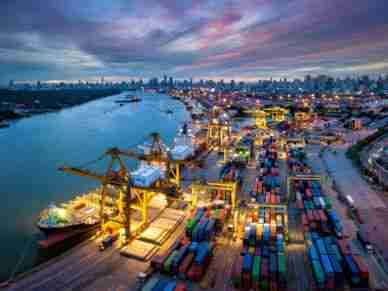Follow These 10 Rules

Effective logistics are critical for keeping any worksite running smoothly, minimizing downtime and meeting deadlines. For industry professionals, mismanaged logistics can lead to costly delays, wasted materials, regulatory challenges and frustrated clients.
Here are specific strategies to ensure seamless operations.
1. Leverage Real-Time Data and Technology Integration
Gone are the days of relying on manual tracking systems. On modern jobsites, logistics must be data-driven. Utilizing real time tracking software for materials, deliveries and equipment allows project managers to identify bottlenecks before they become major setbacks. RFID tags, GPS tracking, IoT-enabled devices and AI provide the transparency needed to optimize workflow and mitigate delays.
In practice, this means integrating software solutions that sync data from all aspects of the worksite in one place. For example, a dashboard that tracks the location of incoming deliveries, usage hours on heavy equipment and worker attendance allows for immediate adjustments.
Machine learning algorithms can predict when and where delays might occur based on current patterns, enabling preemptive action. It’s also important to ensure that all key personnel have access to this system, ensuring smooth coordination across teams.
2. Centralize Communication With Digital Platforms
Clear communication is nonnegotiable for efficient logistics. Adopt centralized communication platforms such as project management apps or jobsite-specific software, to streamline communication between teams, suppliers, managers and contractors. Centralizing communication reduces the risk of misaligned devices, improper installation timing and a lack of materials ensuring everyone stays updated on shifting schedules.
In construction or industrial environments, fragmented communication can lead to scheduling nightmares. A digital platform should support messaging, task assignment, deadline tracking and document sharing. For instance, delivery dates can be linked to calendar events, ensuring all team members receive notifications when materials arrive or certain tasks must be completed.
Furthermore, some systems allow for tracking change orders in real time, meaning any last-minute adjustments are immediately visible across the entire chain of command, reducing costly errors.
3. Plan Deliveries Around Site Constraints
Every jobsite has its own unique set of logistical challenges — whether it’s limited space, narrow access roads or local regulations on heavy vehicle movement. A careful review of site constraints is critical when scheduling deliveries. Work with suppliers to plan delivery windows that account for traffic patterns, peak work hours and the availability of unloading equipment to minimize disruption.
4. Build a Buffer for Material Delays
Even with precise scheduling, delays are inevitable. That’s why experienced professionals understand the value of building a material buffer. Factor in contingency plans for critical materials with long lead times or dependency on weather conditions. While overstocking can lead to wasted resources, a buffer on high-priority items ensures the project doesn’t grind to a halt in case of unexpected delays.
When creating these buffers, it’s crucial to evaluate the specific project needs. Materials with longer supply chains, such as imported goods or custom-fabricated items, should be prioritized in contingency planning. Contracts with suppliers should include clauses allowing flexible delivery windows to account for potential issues. Additionally, stockpile critical materials, such as concrete or steel, when weather-dependent tasks are involved. This minimizes exposure to risks such as poor weather or transport strikes.
5. Simplify Waste Management
Effective waste management is essential for maintaining a clean, safe and compliant jobsite. Simplifying this process reduces environmental impact and enhances operational efficiency. A streamlined waste management system involves clear protocols for sorting, disposing and recycling materials, as well as ensuring that waste removal is aligned with the project schedule.
On-site waste containers should be strategically placed to reduce the distance workers need to travel when discarding materials, thus saving time. Partnering with waste management companies that offer automated tracking and regular pick-ups can also prevent overflows and ensure compliance with local regulations. This reduces the risk of fines and keeps the site organized.
6. Consider Streamlined Billing
Streamlined billing processes are often overlooked in jobsite logistics, yet they’re crucial in maintaining project timelines and budget accuracy. By integrating a centralized billing system, companies can reduce delays caused by invoicing errors, mismatched purchase orders and extended approval time.
For example, M.J. Electric partnered with CMS Logistics to revamp their billing processes. Prior to this integration, their billing would take several days to finalize, creating unnecessary backlogs and preventing their finance department from staying current with project expenses. Through CMS Logistics, M.J. Electric was able to consolidate all their billing data into a single source, spending just half a day on a process that was originally considerably longer.
7. Optimize Equipment Utilization
Idle equipment can drain the project budget. Implement equipment tracking to ensure that cranes, forklifts, equipment and other heavy machinery are in constant use or returned to rental companies when no longer needed. Shared use across teams or subcontractors — where feasible — can also reduce costs while maximizing efficiency.
8. Ensure Compliance With Safety and Regulatory Standards
On every jobsite, safety and compliance should be embedded in logistical planning. Ensure loading and unloading zones are clearly marked, materials are properly stored and all equipment operators have the necessary certifications. Noncompliance or unsafe practices can lead to shutdowns, adding to costs and damaging reputation.
This means regularly reviewing site logistics against safety protocols to prevent accidents. Logistics plans should incorporate designated routes for pedestrian and vehicle traffic, minimizing overlap and reducing the risk of accidents or severe injury.
Compliance checks should be scheduled regularly, with documentation proving all workers operating heavy machinery or hazardous materials have up-to-date certifications. Regular drills and safety audits should be conducted to ensure everyone on site is aware of emergency measures related to logistics, such as what to do in case of a spill or equipment failure.
9. Collaborate Closely With Suppliers
Strong relationships with suppliers are crucial for smooth logistics. Review agreements regularly to ensure suppliers are meeting expectations in terms of delivery times, quality and flexibility. Establishing clear communication lines with suppliers can resolve unforeseen issues more quickly, whether that’s rerouting a delivery or modifying material quantities based on updated project demands.
10. Regularly Audit Your Logistics Processes
Finally, logistics management should be dynamic. Regularly auditing your processes will help identify inefficiencies, from late deliveries to underutilized equipment. Post-project reviews can also provide insights for future improvements. Keep an eye on KPIs such as on-time deliveries, inventory levels and cost-per-delivery to ensure your approach is always improving.
Audits should be proactive and reactive. Schedule logistics reviews throughout the project to catch potential issues before they compound, rather than waiting for a problem to arise. It’s also helpful to track metrics like material wastage, equipment idle times and the frequency of urgent last-minute orders.
Analyzing these figures can reveal bottlenecks or weak points in the supply chain that you can address moving forward. After each project, conduct a debrief to identify what went well and where improvements can be made, setting the groundwork for more efficient logistics on the next job.
Streamline Your Jobsite
Well-managed logistics can make or break a project. Companies can reduce delays and keep projects on track by adopting advanced tracking technologies, optimizing equipment use and building strong supplier relationships.













Leave a Reply